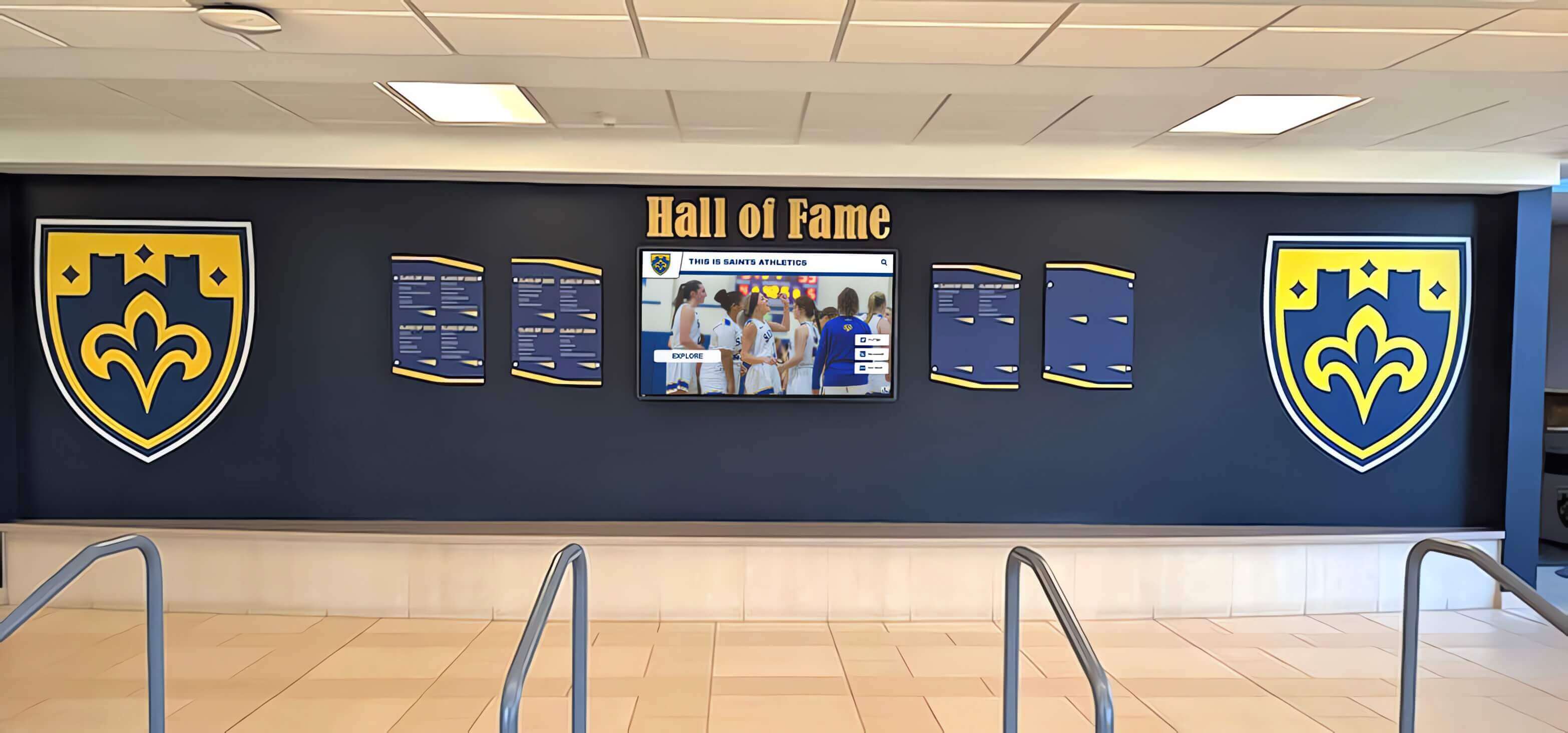Key Takeaways
Comprehensive guide to implementing Thespian Hall of Honor programs in schools. Learn best practices for recognizing theatre excellence, establishing International Thespian Society chapters, and celebrating drama achievements through modern digital displays.
High school and middle school theatre programs create extraordinary moments where students discover confidence, develop creative expression, build collaborative skills, and forge lifelong connections to the performing arts. Yet unlike athletic achievements prominently displayed in trophy cases or academic honors celebrated on permanent honor rolls, theatre accomplishments often receive fleeting recognition—brief applause following closing night, yearbook photos that quickly become historical artifacts, and programs filed away in storage boxes.
This recognition gap sends unintended messages that devalue theatre arts compared to other achievement domains, undermining program visibility, student motivation, alumni engagement, and community support. Theatre students deserve permanent, visible celebration of their dedication, talent, and artistic growth that matches the recognition afforded to accomplishments in other extracurricular areas.
This comprehensive guide explores everything schools and theatre programs need to know about implementing effective Thespian Hall of Honor recognition systems in 2025—from establishing International Thespian Society chapters and developing induction criteria to creating engaging digital recognition displays that bring theatre achievements to life for current students, alumni, and communities.
Understanding Thespian Recognition Programs
Before diving into implementation strategies, theatre programs must understand the landscape of thespian recognition, the role of national honor societies, and how schools can create meaningful celebration systems honoring theatrical excellence.
The International Thespian Society Foundation
The International Thespian Society (ITS) represents the premier recognition organization for middle and high school theatre students in the United States. Founded in 1929 by Dr. Paul Opp, Earnest Bavely, and Harry T. Leeper in Fairmont, West Virginia, the organization was originally named National Thespians before expanding to its current international scope.
As a division of the Educational Theatre Association (EdTA), the International Thespian Society provides standardized frameworks for recognizing student achievement in all aspects of theatre—performance, production, technical theatre, and theatrical scholarship. The organization currently serves thousands of middle schools and high schools through local chapters called “troupes” chartered at individual schools.
Core Mission and Purpose:
The International Thespian Society recognizes, rewards, and encourages student achievement while celebrating the work of students in all theatrical disciplines. Unlike organizations focused solely on performance excellence, ITS acknowledges the comprehensive collaboration required for theatrical production—actors, directors, designers, technicians, stage managers, and countless other specialized roles that bring performances to life.
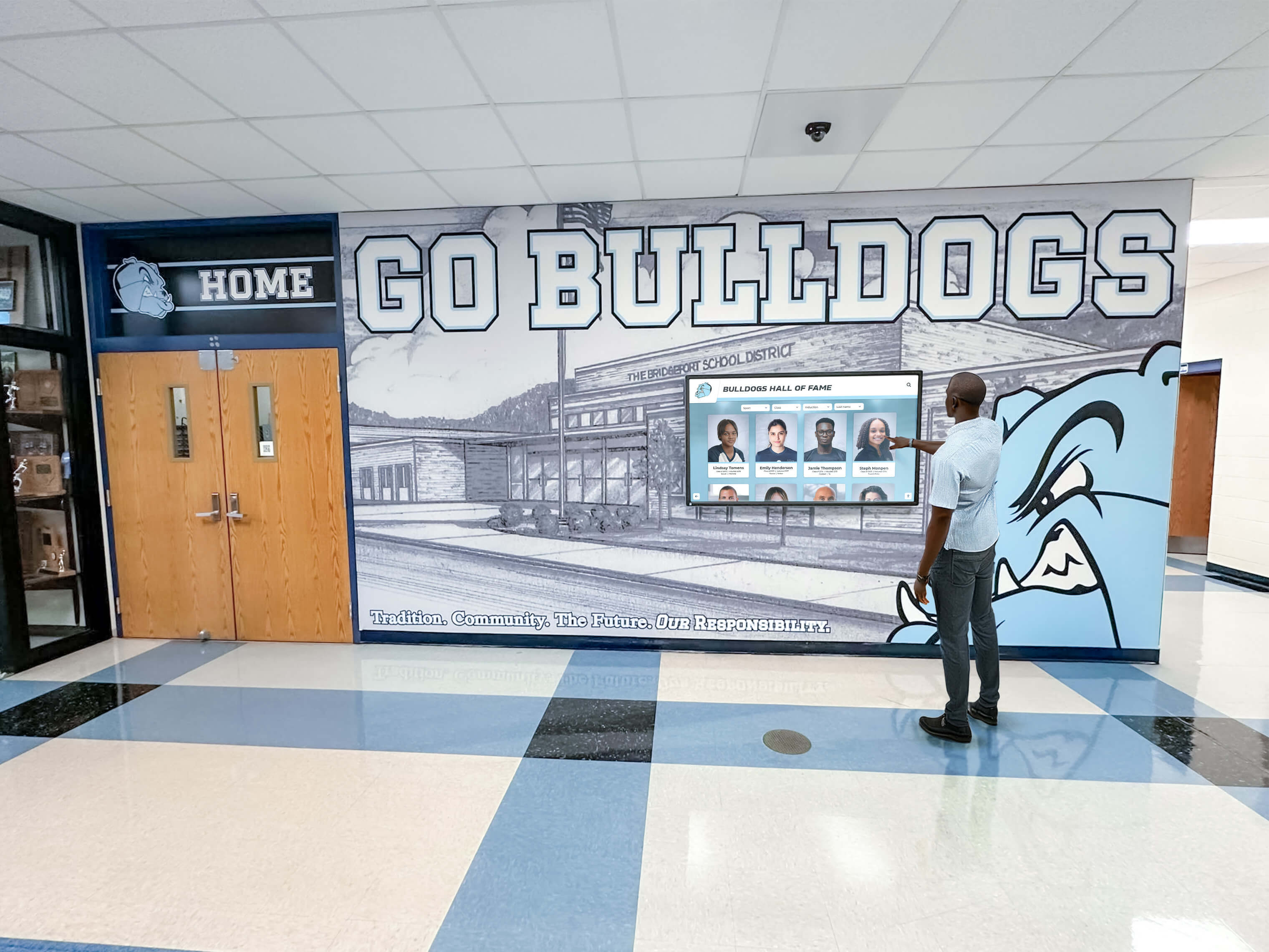
Thespian Recognition Tiers and Honor Ranks
The International Thespian Society employs a point-based system recognizing increasing levels of theatrical achievement and dedication:
Thespian Induction Requirements:
- High School Students (grades 9-12): Students need 10 points, which equals approximately 100 hours of quality theatre work, with at least 5 points earned at their current school
- Middle School Students (grades 6-8): Students need 5 points, representing about 50 hours of theatre work, with at least 3 points earned at their current school
- Points must be earned in at least two different categories (e.g., acting and production) to ensure well-rounded theatrical experience
Advanced Honor Ranks:
Beyond basic Thespian induction, the organization recognizes sustained excellence through advancing honor ranks:
- Honor Thespian: 60 points (approximately 600 hours of theatre work)
- National Honor Thespian: 120 points (approximately 1,200 hours of theatre work)
- International Honor Thespian: 180+ points (1,800+ hours of dedication to theatre)
These tiered recognition levels acknowledge that theatre education represents not just participation but sustained commitment, skill development, and deepening artistic engagement over time. Students advancing through honor ranks demonstrate extraordinary dedication deserving special acknowledgment.
State-Level Recognition Programs
While the International Thespian Society provides national structure, many states have developed additional recognition frameworks celebrating theatrical excellence at regional levels.
State Thespian Festivals and Competitions:
Most state thespian organizations host annual festivals where students compete, perform, attend workshops, and celebrate theatrical achievement. These festivals typically include competitive categories for individual events (monologues, duet scenes, musical theatre solos), technical theatre demonstrations, production design portfolios, and ensemble performances.
State festivals provide external validation of theatrical excellence through adjudication by theatre professionals and educators from across the region. Superior and excellent ratings earned at state festivals represent significant achievements worthy of permanent recognition.
State-Specific Hall of Fame Programs:
Some states, including Texas, maintain state-level Hall of Fame programs honoring adults who have dedicated 20 or more years to educational theatre. The Texas Thespian Hall of Fame, for example, recognizes theatre educators who have made exceptional contributions to developing young artists across their careers.
While these adult recognition programs differ from student-focused Hall of Honor systems, they provide models for celebrating sustained excellence and contribution to theatrical communities that schools can adapt for student recognition.
Defining “Thespian Hall of Honor” for Your Program
The term “Hall of Honor” isn’t an official designation within the International Thespian Society structure but represents a recognition concept schools and theatre programs can implement to celebrate theatrical excellence within their specific communities.
A Thespian Hall of Honor typically refers to permanent recognition systems—physical displays, digital platforms, or hybrid approaches—that celebrate outstanding theatrical achievement including:
- Students inducted into the International Thespian Society
- Individuals achieving advanced honor ranks (Honor Thespian, National Honor Thespian, International Honor Thespian)
- Outstanding theatrical performances and productions
- Technical theatre excellence in design and execution
- Competition achievements at district, regional, state, and national levels
- Alumni who have pursued professional theatre careers or maintained theatrical engagement
- Theatre educators and directors who have built exceptional programs
Schools implementing Thespian Hall of Honor recognition create visible, permanent celebration complementing the external recognition provided by International Thespian Society membership while addressing the specific culture, traditions, and achievements unique to their programs.
Establishing an International Thespian Society Troupe
For schools without existing ITS chapters, establishing a troupe represents the foundation for comprehensive thespian recognition programs. Understanding the requirements and processes ensures successful chapter implementation.
Troupe Charter Requirements
Schools must meet specific criteria to charter an International Thespian Society troupe:
Minimum Membership Requirements:
Each troupe must maintain an active member base of at least six officially inducted Thespians at all times. This requirement ensures sufficient membership to conduct troupe activities, fill officer positions, and maintain organizational sustainability.
Adult Sponsorship:
Troupes require a faculty sponsor—typically the school’s theatre director or drama teacher—who serves as the troupe director. This adult sponsor manages troupe operations, coordinates with the Educational Theatre Association, facilitates inductions, and ensures compliance with organizational standards.
School Affiliation:
Troupes must be affiliated with accredited schools (middle schools or high schools) providing theatre education programming. Schools without formal theatre classes may still charter troupes if they offer substantial co-curricular theatre activities through drama clubs or production programs.
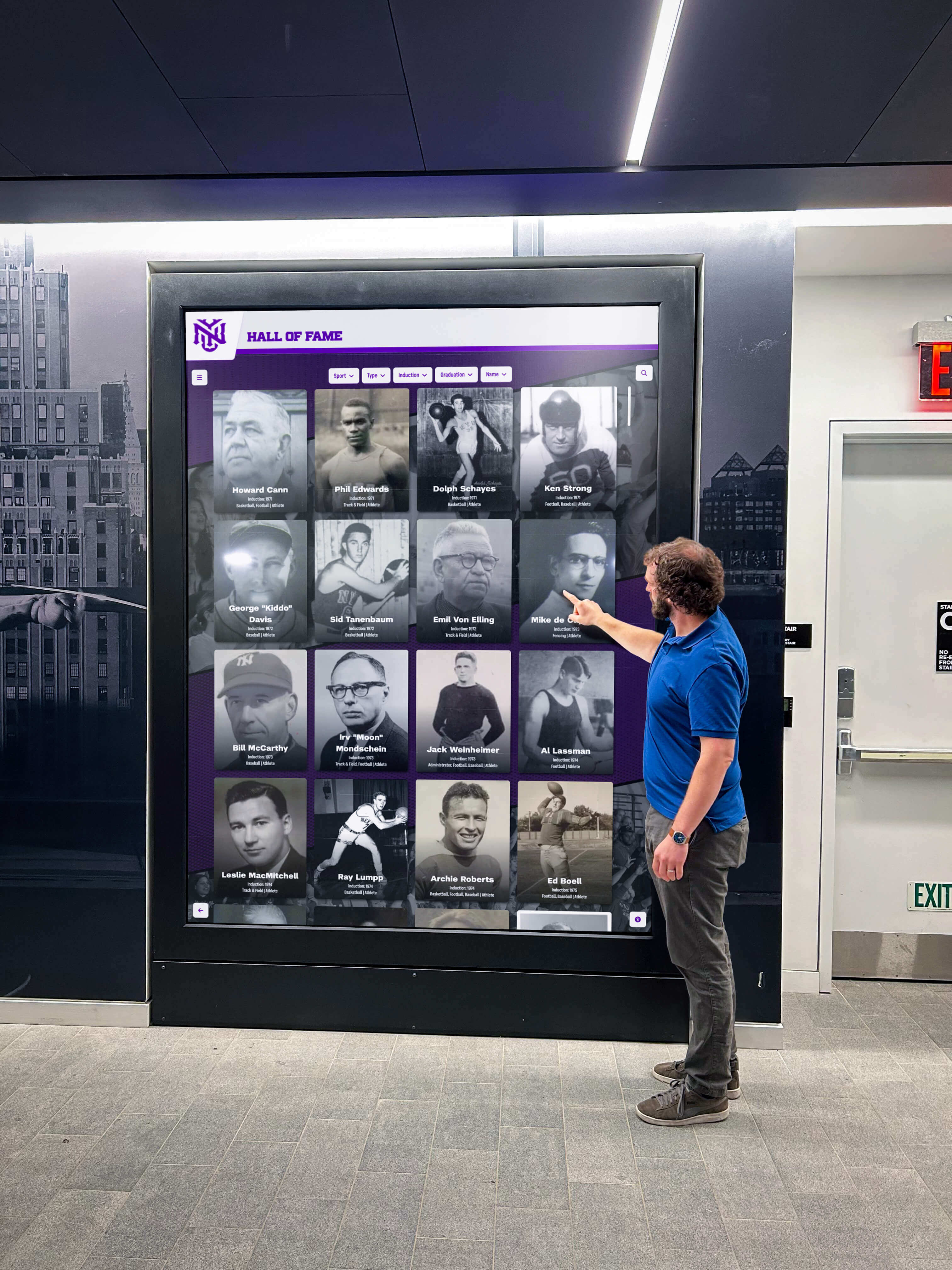
The Point System for Theatrical Achievement
The International Thespian Society uses a standardized point system ensuring consistent recognition criteria across schools nationwide. Understanding how points are earned helps students and directors plan recognition pathways.
Point Categories and Examples:
One Thespian point represents approximately ten hours of quality theatre work. Points can be earned through:
Performance:
- Principal roles in major productions
- Supporting roles in performances
- Ensemble performances in multiple productions
- Musical theatre performances combining acting, singing, and dancing
Technical Theatre and Design:
- Set construction and scenic design
- Lighting design and execution
- Sound design and engineering
- Costume design and construction
- Properties design and management
- Stage management coordination
- Makeup design and application
Production Support:
- Running crew for multiple performances
- House management and audience services
- Publicity and marketing contributions
- Program design and production
- Backstage coordination
Theatre Scholarship:
- Dramaturgy and research
- Playwriting and adaptation
- Theatre history projects
- Criticism and review writing
- Theatre education and mentoring
The point system’s comprehensiveness ensures recognition extends beyond actors to acknowledge the collaborative nature of theatrical production. Set builders, lighting technicians, costume designers, and stage managers receive equal recognition for their essential contributions.
Point Documentation:
Students maintain individual point records documenting all theatrical activities, hours invested, and roles performed. Troupe directors verify point records before submitting induction applications, ensuring accuracy and compliance with Educational Theatre Association standards.
Induction Process and Ceremonies
Once students accumulate required points and meet eligibility criteria, formal induction ceremonies mark their entry into the International Thespian Society.
Application and Approval:
- Students complete Thespian Induction Applications capturing personal details and outlining theatre involvement
- Students document activities using Point Record Sheets logging all work
- Troupe directors review applications and verify point calculations
- Students pay one-time induction fees (set by EdTA with potential troupe-assessed additional participation fees)
- Applications are submitted to the Educational Theatre Association for official membership processing
Induction Ceremony Elements:
Induction ceremonies vary by troupe but commonly include:
- Formal program explaining International Thespian Society history, mission, and significance
- Recognition of each inductee with names announced and achievements summarized
- Presentation of membership materials including membership cards, certificates, and official Thespian pins
- Ceremonial elements unique to individual troupes (candle lighting, oath recitation, special traditions)
- Reception or celebration following the formal ceremony
Many troupes coordinate inductions with significant theatrical events—opening nights of major productions, drama banquets, or special recognition ceremonies—maximizing family attendance and community visibility.
Post-Induction Benefits and Opportunities:
After induction, students gain access to exclusive International Thespian Society benefits including eligibility for national and regional theatre festivals, scholarship opportunities supporting theatre education and college attendance, leadership positions within local troupes, specialized graduation recognition and regalia, and networking connections with theatre professionals and programs.
Designing Comprehensive Thespian Recognition Systems
While International Thespian Society membership provides external validation, schools can create comprehensive local recognition systems celebrating theatrical excellence within their specific communities and traditions.
Recognition Categories for Theatre Programs
Effective Thespian Hall of Honor programs acknowledge diverse forms of theatrical achievement ensuring all contributions receive appropriate celebration.
Individual Performance Excellence:
- Outstanding lead performance (dramatic)
- Outstanding lead performance (comedic)
- Outstanding musical theatre performance
- Outstanding ensemble performance
- Character actor of the year
- Most improved performer
- Breakthrough performance recognition
Technical Theatre and Design Achievement:
- Outstanding set design
- Outstanding lighting design
- Outstanding sound design
- Outstanding costume design
- Outstanding properties design
- Outstanding stage management
- Outstanding makeup design
- Technical innovation award
Production Contribution Recognition:
- Outstanding director (student-directed productions)
- Outstanding assistant director
- Outstanding choreographer
- Outstanding musical director
- Outstanding dramaturgy
- Outstanding production management
- Outstanding publicity and marketing
Sustained Excellence Awards:
- International Thespian Society inductees
- Honor Thespian achievement
- National Honor Thespian achievement
- International Honor Thespian achievement
- Four-year participation recognition
- Leadership and mentorship awards
Competition and Festival Achievements:
- State festival superior ratings
- Individual event competition awards
- One-act play competition recognition
- Technical theatre competition honors
- All-state theatre selections
Special Recognition Categories:
- Troupe spirit and enthusiasm
- Most versatile performer/technician
- Outstanding collaboration
- Theatre advocacy and promotion
- Community service through theatre
By establishing diverse recognition categories, programs ensure that actors, technicians, designers, directors, managers, and support personnel all experience acknowledgment for their essential contributions to theatrical productions.
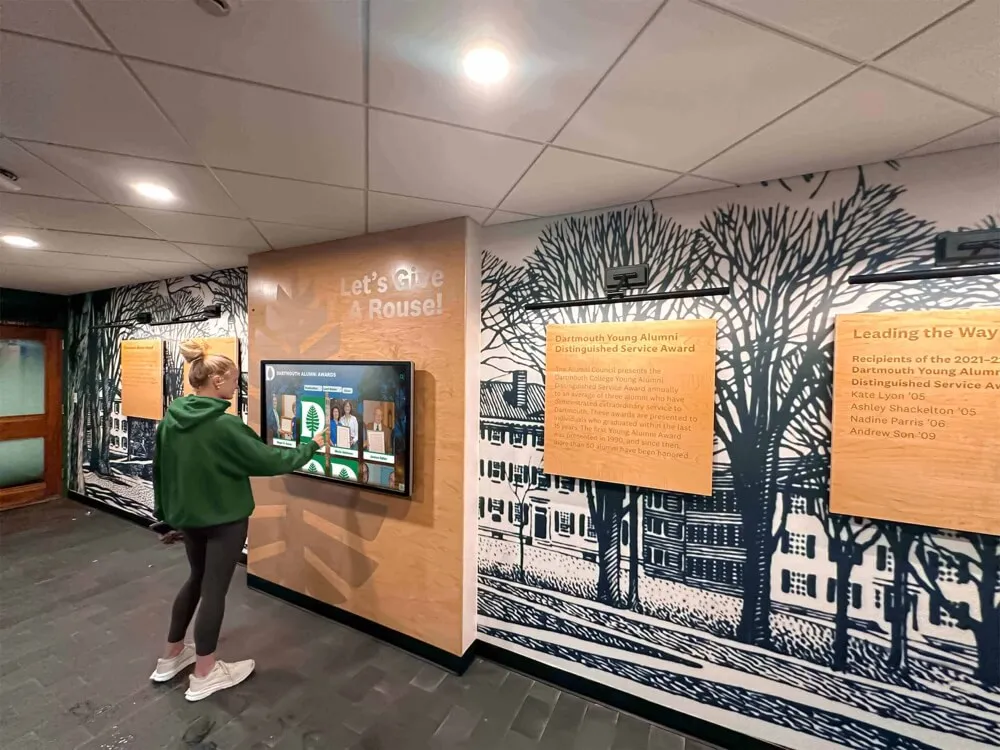
Establishing Selection Criteria and Processes
Clear, transparent selection criteria prevent perceptions of favoritism while maintaining recognition prestige and meaning.
Criteria Development Considerations:
When establishing recognition criteria, consider:
Achievement Standards: Define specific accomplishments qualifying for each recognition category. “Outstanding performance” might require leading role in major production, consistently excellent work across multiple productions, positive faculty evaluation, demonstration of significant skill development, and contribution to overall production quality.
Nomination Procedures: Determine who can nominate students for recognition. Options include faculty nominations from directors and theatre teachers, peer nominations from troupe members, self-nomination with supporting materials, or automatic consideration based on objective achievement (e.g., point totals, festival ratings).
Selection Committee Structure: Establish who makes final recognition decisions. Committees might include theatre faculty and directors, student troupe officers, guest adjudicators from community theatre, administrators providing institutional perspective, and potentially rotating alumni representatives.
Transparency and Documentation: Publish criteria clearly in troupe handbooks, program materials, and school communications so students understand recognition pathways. Document selection processes and maintain consistent application across years building fairness perceptions essential for recognition credibility.
Annual Recognition Rhythms and Cycles
Establishing consistent recognition rhythms creates traditions students anticipate while maintaining fresh engagement throughout theatrical seasons.
Seasonal Recognition Opportunities:
Fall:
- New Thespian inductions following point accumulation during previous school year
- Summer theatre camp or workshop participation recognition
- Opening of theatre season celebration honoring returning members
- Welcome and integration of new troupe members
Winter:
- Fall production recognition following semester performances
- Competition and festival achievement celebration
- Mid-year troupe awards recognizing first-semester contributions
- Holiday theatre traditions and special events
Spring:
- Spring production recognition
- State festival and competition achievement celebration
- Annual troupe awards and banquet
- Senior recognition and graduation celebrations
- End-of-year Thespian inductions for newly eligible students
Summer:
- Alumni theatre achievements update
- Summer theatre program participation
- College theatre program matriculation celebration
- Planning for upcoming season recognition
Regular recognition touchpoints throughout the year maintain visibility and engagement while creating multiple opportunities for students to experience acknowledgment rather than concentrating all recognition into single annual events.
Implementing Digital Theatre Recognition Displays
Traditional theatre recognition—programs saved in boxes, cast photos in hallway displays, occasional trophy case plaques—fails to capture the dynamic, multimedia nature of theatrical art. Digital recognition displays transform how schools celebrate theatrical achievement through engaging, comprehensive platforms.
Advantages of Digital Thespian Recognition
Digital displays specifically designed for theatre recognition offer substantial advantages over traditional static approaches:
Multimedia Performance Documentation: Unlike static photos, digital platforms showcase actual performances through video clips, allowing current students and visitors to experience celebrated performances rather than merely reading about them. Integration of performance video, backstage documentation, design renderings and finished products, audio from musical performances, and rehearsal process documentation brings theatrical achievements to life comprehensively.
Comprehensive Production Archives: Digital systems enable complete documentation of every production including full cast and crew listings ensuring everyone receives recognition, production photos documenting memorable scenes and moments, program information preserving show details, director’s notes explaining artistic vision, reviews and audience feedback, and historical context connecting productions to program traditions.
Interactive Exploration: Touchscreen interfaces invite active engagement rather than passive viewing. Visitors can search by student name to find alumni or family members, browse by production title exploring specific shows, filter by year discovering program evolution, view technical theatre portfolios showcasing design work, and access Thespian Society member profiles with achievement histories.
Unlimited Recognition Capacity: Physical display space limitations force difficult choices about which achievements to celebrate. Digital platforms eliminate space constraints entirely, accommodating unlimited inductees, productions, awards, photos, videos, and historical documentation spanning decades without sacrificing any recognition opportunities.
Easy Content Updates: Adding new inductees, uploading production photos, or recognizing recent achievements requires simple content management rather than physical construction, engraving, or display modification. Theatre teachers can update recognition content from any device through web-based interfaces requiring no technical expertise.
Solutions like Rocket Alumni Solutions provide purpose-built platforms specifically designed for educational recognition including theatre programs, offering intuitive content management, engaging multimedia presentation, and proven approaches helping schools celebrate theatrical excellence comprehensively.

Content Development for Theatre Recognition
Effective digital recognition requires thoughtful content development that tells complete stories rather than simply listing names and titles.
Individual Thespian Profiles:
Each International Thespian Society member profile should include:
- Professional-quality headshot or performance photo
- Graduation year and class affiliation
- Current honor rank (Thespian, Honor Thespian, National Honor Thespian, International Honor Thespian)
- Complete production history listing all shows and roles
- Technical theatre contributions across all productions
- Competition achievements and festival recognitions
- Awards and special recognition received
- Personal statement about theatrical journey and impact
- Post-graduation theatrical engagement and career updates
Production Archives:
Complete documentation for each theatrical production creates permanent institutional memory:
- Production title, playwright, performance dates
- Director and production team credits
- Complete cast list with role assignments
- Complete crew list with technical specialties
- Production photos featuring key scenes and moments
- Video highlights capturing memorable performances
- Set design renderings and construction photos
- Costume design portfolios and finished products
- Lighting and sound design documentation
- Program scans preserving contextual information
- Audience size and community response
- Awards or recognition earned
Competition and Festival Documentation:
External validation through competitions and festivals deserves special recognition:
- Event name, location, and date
- Individual competitors and performance categories
- Ratings earned (superior, excellent, good)
- Placement and special awards
- Adjudicator comments and feedback
- Performance recordings when available
- All-state selections and honors
- Progression through competitive levels (district → regional → state → national)
Placement Strategy for Theatre Recognition Displays
Strategic placement ensures theatre recognition reaches appropriate audiences while reinforcing program visibility throughout school communities.
Performing Arts Center Locations:
Theatre facilities provide natural homes for recognition displays:
- Main lobby areas where audiences gather before performances and during intermission
- Green room or backstage areas inspiring current troupe members
- Box office or ticketing areas reaching all patrons
- Rehearsal space entrances reinforcing program tradition and excellence
- Theatre classroom spaces where students learn theatrical foundations
School-Wide High-Traffic Areas:
Extending recognition beyond theatre-specific spaces increases visibility:
- Main school entrance lobbies reaching all students, staff, and visitors daily
- Main hallway corridors with high student traffic
- Cafeteria spaces where students gather
- Library or media center locations encouraging exploration during free time
- Athletic facility entrances demonstrating equivalence between theatrical and athletic achievement
Virtual and Remote Access:
Modern recognition extends beyond physical displays:
- Web-accessible versions allowing worldwide alumni access
- Mobile-friendly interfaces supporting smartphone exploration
- Social media integration enabling sharing of student achievements
- Email announcement integration connecting recognition to school communication
- Virtual tour inclusion for prospective families researching programs
Multiple display locations—combining dedicated theatre space recognition with strategic school-wide placement—maximize visibility while reaching diverse audiences with different connections to theatre programs.
Building Theatre Hall of Honor Program Culture
Technology and systems provide recognition infrastructure, but sustainable programs require cultural integration ensuring theatre recognition becomes embedded in school and troupe identity.
Annual Traditions and Signature Events
Consistent traditions create anticipated moments that strengthen troupe identity and recognition impact.
Thespian Induction Ceremony:
Formal induction ceremonies represent signature recognition events deserving careful planning and consistent execution. Many successful programs schedule inductions as special events separate from regular productions, allowing focused attention on new inductees without competing with performance logistics. Induction ceremonies might include formal programs explaining Thespian Society significance, individual inductee recognition with achievement summaries, ceremonial elements unique to your troupe traditions, presentation of official membership materials, and reception celebrating new members and their families.
Annual Troupe Awards Banquet:
Year-end celebrations allow comprehensive recognition across all categories. Troupe banquets typically include dinner or reception bringing community together, formal awards ceremony recognizing diverse achievements, senior sendoff celebrating graduating troupe members, officer transition acknowledging leadership contributions, video retrospective highlighting year’s productions and moments, and entertainment from troupe members showcasing talent. Banquets become anticipated traditions marking seasonal closure while celebrating collective and individual excellence.
Production Opening and Closing Traditions:
Integrate recognition into regular production rhythms:
- Opening night acknowledgment of production team
- Closing night senior recognition for graduating performers and technicians
- Post-production cast/crew parties celebrating collaborative achievement
- “Strike” celebrations recognizing technical crew and set construction teams
- Parent/family appreciation events for production support
State Festival and Competition Traditions:
Create rituals around competitive events:
- Send-off celebrations before festival departure
- Social media recognition while competitions occur
- Welcome-back celebrations honoring achievement
- Display of ratings and awards in prominent locations
- Addition of festival achievements to permanent recognition systems
Traditions establish predictable patterns creating anticipation, building community, and reinforcing that theatrical achievement receives systematic recognition comparable to accomplishments in other domains.
Alumni Engagement Through Theatre Recognition
Theatre alumni often maintain strong emotional connections to programs that shaped their development. Recognition systems can deepen these connections while benefiting current students through mentorship and support.
Alumni Spotlight Programs:
Feature accomplished theatre alumni in recognition systems:
- Professional theatre career pathways
- Non-theatre careers where theatrical skills provide advantage
- Community theatre continued engagement
- Educational theatre careers inspiring future generations
- Testimonials about high school theatre program impact
Alumni spotlights demonstrate long-term value of theatre education while providing relatable role models inspiring current students that theatrical skills support diverse life pathways. Resources on alumni engagement through digital recognition explore strategies for maintaining meaningful alumni connections benefiting programs and students.
Reunion and Networking Events:
Leverage recognition systems to facilitate alumni engagement:
- Reunion events scheduled around major productions
- Alumni performance opportunities in special shows
- Networking mixers connecting current students with alumni professionals
- Mentorship program coordination pairing students with alumni
- Career panels featuring theatre alumni across diverse professions
Alumni Contribution Recognition:
Acknowledge alumni who support programs:
- Financial donors funding productions, scholarships, or improvements
- Guest artists providing workshops or masterclasses
- Professional mentors offering career guidance
- Volunteers assisting with productions or technical work
- Advocates promoting program value to broader communities

Integrating Theatre Recognition with School Culture
The most effective theatre recognition programs extend beyond drama departments to become integrated components of broader school communities.
Cross-Curricular Connections:
Highlight relationships between theatre and other disciplines:
- English class connections through dramatic literature
- History class relationships exploring theatrical periods
- Art class collaborations on scenic and costume design
- Music department partnerships in musical theatre
- Technology class applications in lighting and sound design
- Communications class skills in publicity and marketing
Emphasizing cross-curricular connections demonstrates theatre education’s comprehensive value rather than positioning programs as isolated extracurriculars.
School-Wide Theatre Promotion:
Extend theatre visibility throughout school communities:
- Display theatre achievements in main school displays alongside athletic and academic honors
- Include theatre recognition in school newsletters and communications
- Feature theatre students in school social media celebrating diverse excellence
- Invite administration to attend performances and recognition events
- Present theatre awards at school-wide recognition assemblies
Community Partnerships and Visibility:
Strengthen community connections through theatre recognition:
- Local media coverage of productions and achievements
- Community theatre partnerships and collaborations
- Performance opportunities at community events
- Educational outreach to elementary and middle schools
- Business partnership recognition in programs and displays
When theatre recognition extends beyond drama classrooms to permeate school culture and community awareness, programs gain visibility, support, and sustainability essential for long-term excellence.
Implementation Planning and Execution
Schools ready to implement comprehensive Thespian Hall of Honor recognition should follow systematic planning ensuring successful launches and sustainable operations.
Phase 1: Planning and Assessment
Establish Planning Committee:
Form diverse committee including:
- Theatre director/drama teacher providing program leadership
- Troupe officers representing student perspective
- Administrator offering institutional support
- Technology coordinator addressing technical considerations
- Communications staff supporting visibility and promotion
- Parent representative ensuring family perspective
- Alumni representative connecting to program history
Assess Current Recognition State:
Evaluate existing recognition approaches:
- How does the program currently recognize achievement?
- What recognition do students, families, and alumni value most?
- What gaps exist in current recognition systems?
- What budget and resources are available?
- What technical infrastructure exists?
Define Recognition Objectives:
Establish clear goals for recognition programs:
- Increase student motivation and participation
- Strengthen alumni engagement and connection
- Improve community visibility and support
- Provide equitable recognition across all theatrical disciplines
- Create sustainable recognition requiring minimal ongoing resources
- Build traditions strengthening troupe culture and identity
Phase 2: Design and Development
Determine Recognition Framework:
Make key decisions about program structure:
- What recognition categories will the program include?
- What criteria qualify students for each recognition level?
- Who nominates students and how are selections made?
- How frequently will recognition occur?
- What ceremonies or traditions will mark recognition?
- How will recognition integrate with ITS membership?
Select Technology Platform:
Evaluate digital recognition solutions considering:
- Content management ease for non-technical users
- Multimedia capabilities supporting video, images, and rich content
- Search and filtering functionality enabling visitor exploration
- Cloud-based systems eliminating server maintenance
- Integration with existing school systems
- Support, training, and implementation assistance provided
- Total cost of ownership including hardware, software, implementation, and ongoing operation
Solutions like those from Rocket Alumni Solutions provide comprehensive platforms specifically designed for educational recognition including specialized features for performing arts programs.
Develop Initial Content:
Begin content creation for launch:
- Current Thespian Society members with profiles
- Recent productions with comprehensive documentation
- Competition and festival achievements from current year
- Senior recognition celebrating graduating class
- Historical highlights connecting to program traditions
Initial content demonstrates system capabilities while creating foundation for ongoing expansion.
Phase 3: Implementation and Launch
Hardware Installation:
Physical installation requirements include:
- Display screen selection and purchase
- Professional mounting at appropriate heights and locations
- Network connectivity ensuring reliable internet access
- Electrical wiring by licensed electricians
- Cable management creating clean, professional appearance
Content Population:
Systematically add recognition content:
- Import Thespian member data and profiles
- Upload production photos and videos
- Document competition achievements
- Create historical archives from available materials
- Develop category structures and navigation
- Test search and filtering functionality
Training and Communication:
Prepare community for launch:
- Train theatre faculty and troupe officers on content management
- Educate students about recognition criteria and processes
- Communicate launch to families through newsletters and social media
- Inform administration and broader school community
- Generate media coverage for broader visibility
Launch Celebration:
Formal unveiling creates momentum:
- Schedule launch event around significant theatrical occasion
- Invite students, families, alumni, administration, and community
- Demonstrate system capabilities and features
- Recognize initial honorees
- Generate social media content extending reach
Phase 4: Ongoing Operation and Enhancement
Establish Content Update Rhythms:
Create sustainable update schedules:
- Add new Thespian inductees immediately following ceremonies
- Upload production content within weeks of closing nights
- Document competition achievements upon return from festivals
- Feature rotating spotlights on different students monthly
- Maintain regular content freshness sustaining engagement
Monitor Engagement and Impact:
Track program effectiveness:
- Visitor interaction with digital displays
- Student and family feedback about recognition
- Alumni engagement and participation
- Troupe membership and participation trends
- Community visibility and support indicators
Continuous Improvement:
Refine programs based on experience:
- Add recognition categories addressing identified gaps
- Enhance content quality based on feedback
- Expand historical archives as materials become available
- Improve nomination and selection processes
- Strengthen traditions and ceremonies
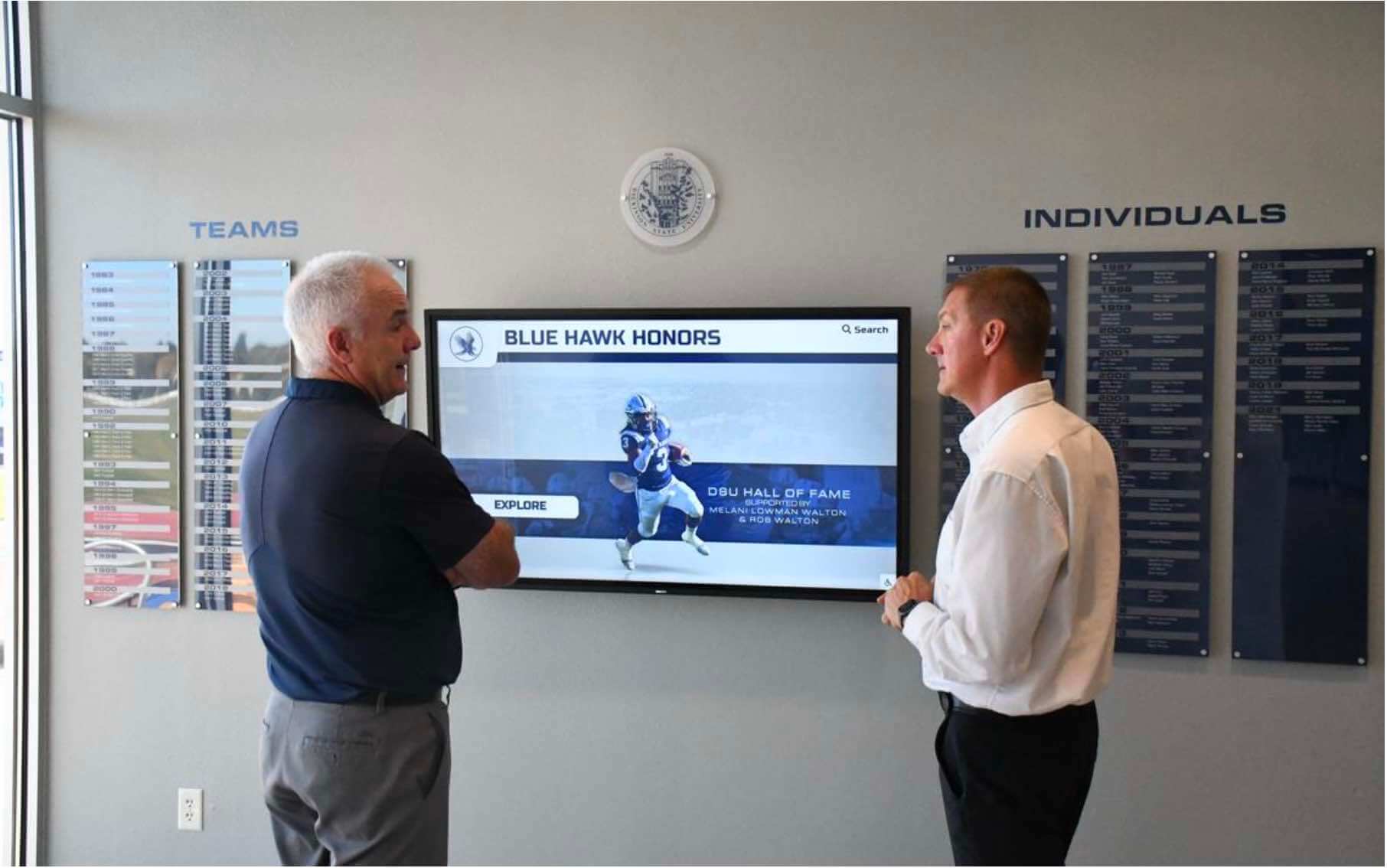
Budget Considerations and Funding Strategies
Understanding financial requirements helps programs develop realistic implementation plans while identifying creative funding approaches.
Investment Components
Technology Infrastructure:
Initial investments typically include:
- Display hardware ranging from $2,000-$8,000 depending on size and features
- Mounting systems and protective enclosures providing security and professional appearance
- Installation costs including electrical and network infrastructure
- Software platform subscriptions typically $1,200-$3,500 annually
- Initial content development time investment
Ongoing Operational Costs:
Annual expenses include:
- Software subscriptions and platform support
- Content development time as ongoing operational expense
- Hardware maintenance and eventual replacement
- Professional development ensuring staff maximize platform capabilities
Most operational costs represent time rather than hard dollar expenses, particularly once initial content libraries are established and update rhythms become routine.
Recognition Materials and Ceremonies:
Complementary recognition investments include:
- Physical awards for major achievements
- Induction ceremony expenses
- Banquet and celebration costs
- Programs and printing for ceremonies
- Graduation regalia and cords for Thespians
Funding Approaches
Operating Budget Allocation:
Include theatre recognition in regular budgets as core educational expense rather than discretionary addition. Recognition supporting educational programs deserves sustained funding commitment comparable to other instructional investments.
Theatre Booster Organizations:
Engage parent booster clubs and support organizations in funding recognition systems. Many supporters willingly fund initiatives demonstrating tangible program impact and celebrating student achievement visibly.
Grant Opportunities:
Explore grant funding from:
- Arts education foundations supporting theatre programs
- Corporate giving programs especially technology companies
- Local arts councils supporting educational initiatives
- Educational technology grants for innovative approaches
Fundraising Campaigns:
Consider dedicated fundraising for recognition systems:
- Capital campaigns for major projects
- Brick or plaque sponsorship programs
- Annual fund drives supporting operations
- Production program advertising supporting technology
- Alumni giving campaigns focused on recognition
Phased Implementation:
Begin with priority content and single display locations, expanding systematically as funding permits. Phased approaches demonstrate value building support for continued investment while providing immediate recognition benefits.
Resources on digital recognition implementation provide detailed planning frameworks applicable to theatre recognition programs.
Conclusion: Celebrating Theatre Excellence Permanently
Theatre programs deserve recognition systems matching their educational importance and celebrating creative achievement with the permanence, visibility, and engagement afforded to accomplishments in other domains. When schools implement comprehensive Thespian Hall of Honor programs—combining International Thespian Society membership, diverse local recognition categories, and engaging digital displays—they validate that theatrical excellence matters equally alongside athletic and academic achievement while inspiring continued dedication across all student populations.
The most effective theatre recognition programs share common characteristics: clear criteria consistently applied across all students and theatrical disciplines, diverse recognition categories celebrating performance, technical theatre, design, leadership, and sustained contribution, meaningful ceremonies and traditions making recognition genuinely special, modern technology enhancing visibility and accessibility, comprehensive content telling complete stories rather than simply listing names, family and community engagement amplifying recognition impact, and sustainable implementation persisting across leadership changes.
Theatre education builds essential skills including creative expression, collaborative teamwork, confident communication, problem-solving, and dedication that benefit students throughout their personal and professional lives. Recognition programs that celebrate theatrical achievement appropriately honor these outcomes while creating visible cultures where performing arts receive the respect and support they deserve.
Modern solutions like Rocket Alumni Solutions provide comprehensive platforms designed specifically for educational recognition including specialized capabilities for theatre programs, offering intuitive content management, engaging interactive displays, multimedia presentation capabilities, and proven approaches helping schools build recognition cultures their theatre students deserve. Whether implementing programs for performing arts showcases, comprehensive student achievement displays, or integrated recognition systems, digital technology enables schools to celebrate theatre excellence more comprehensively and effectively than ever before.
Ready to transform how your school celebrates theatre achievement? Explore comprehensive recognition solutions that honor student theatrical excellence while building program cultures where performing arts receive genuine celebration and all students pursuing theatre can see their dedication acknowledged appropriately. Your theatre students create extraordinary performances and dedicate countless hours to theatrical excellence every day—effective Thespian Hall of Honor programs ensure those achievements receive the permanent recognition they deserve.
